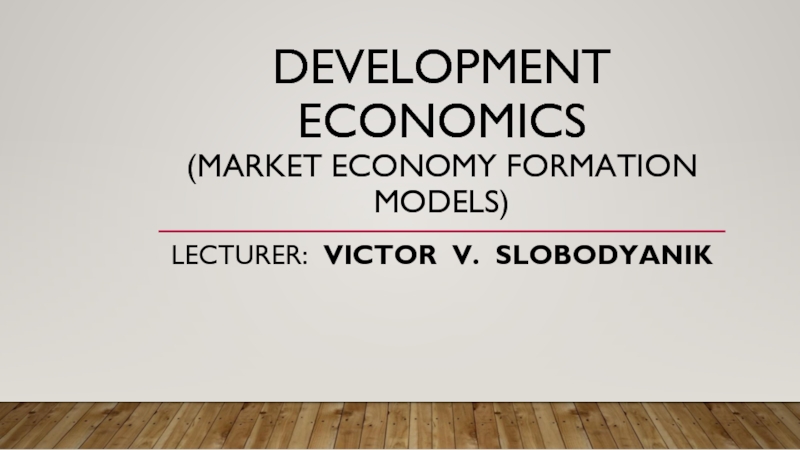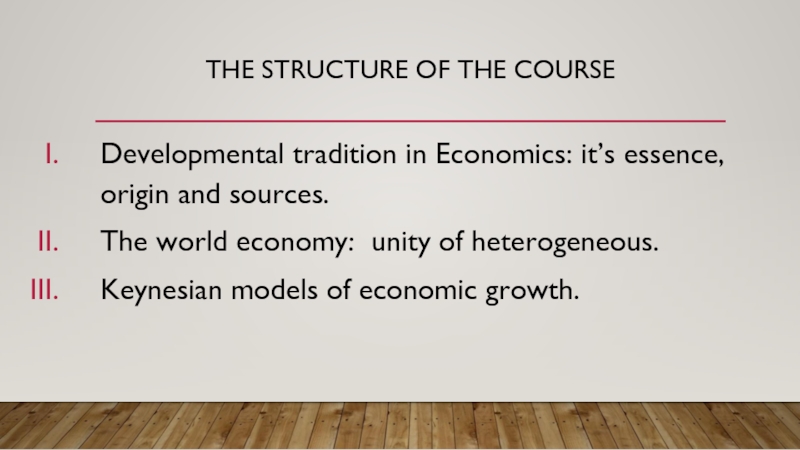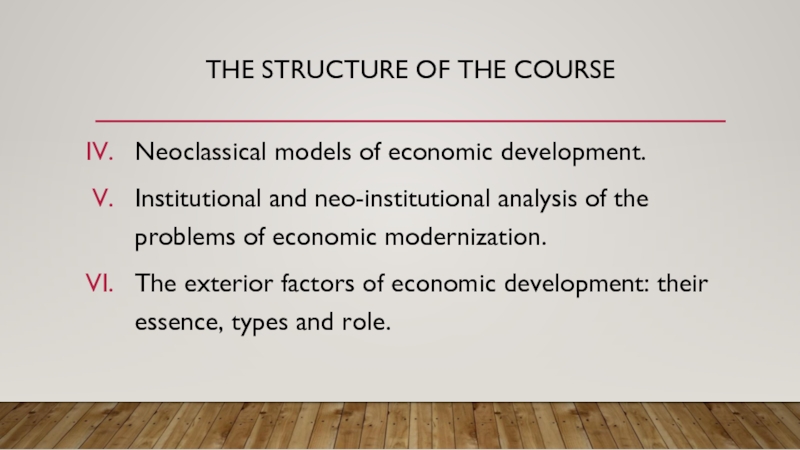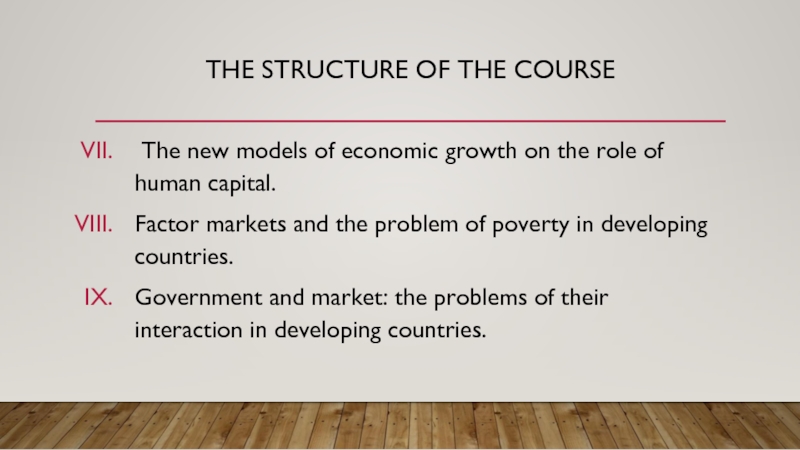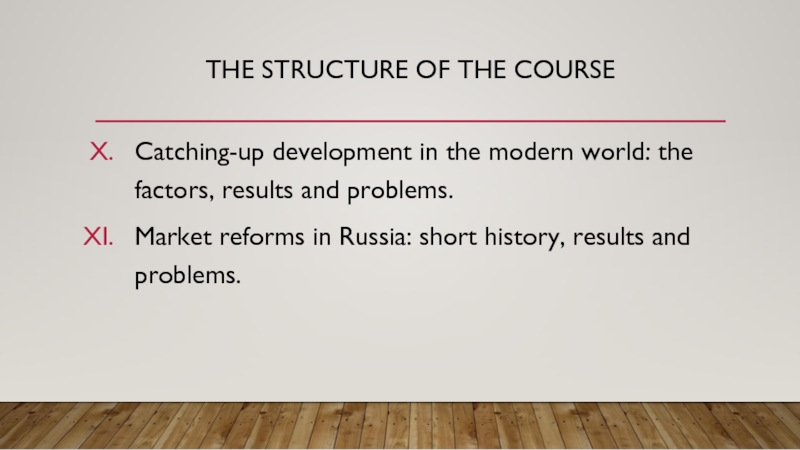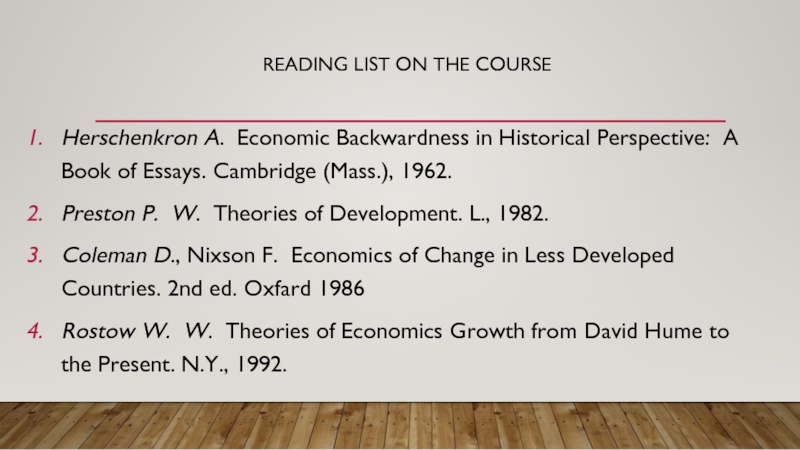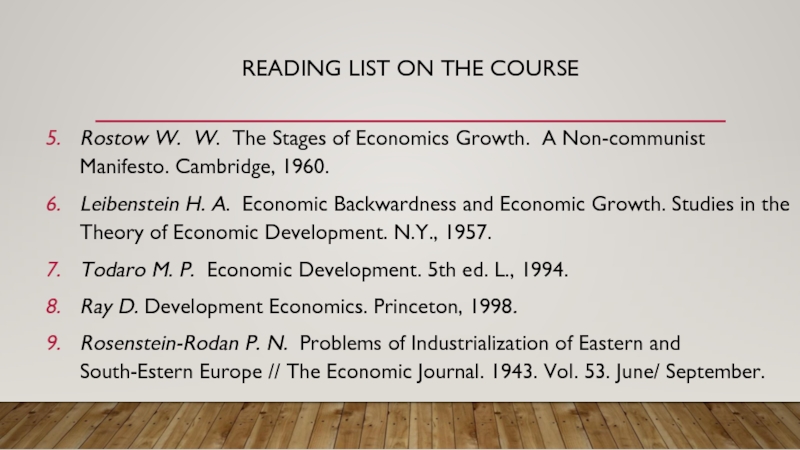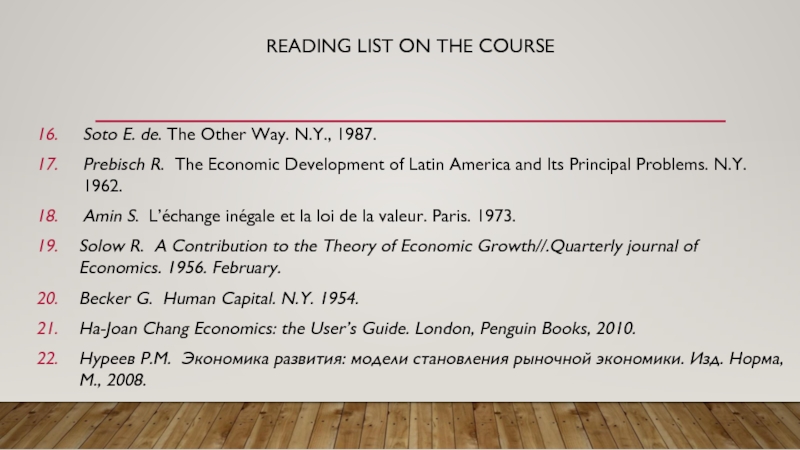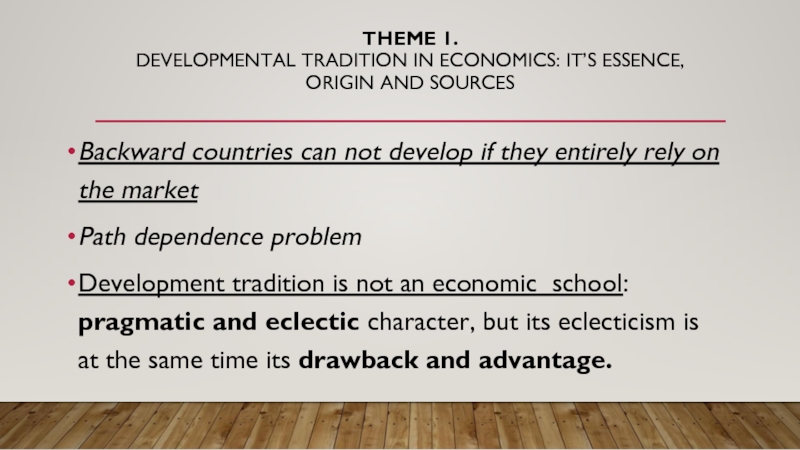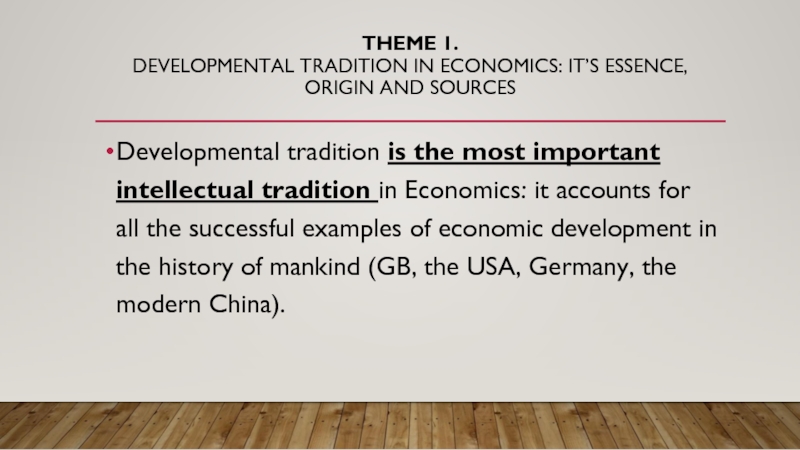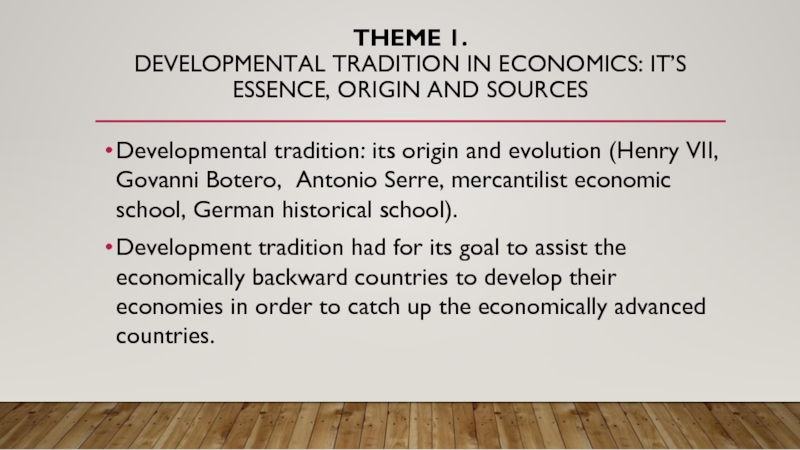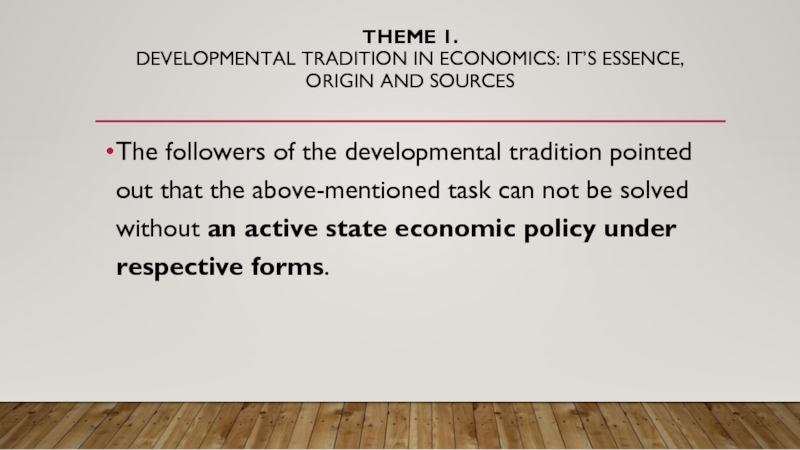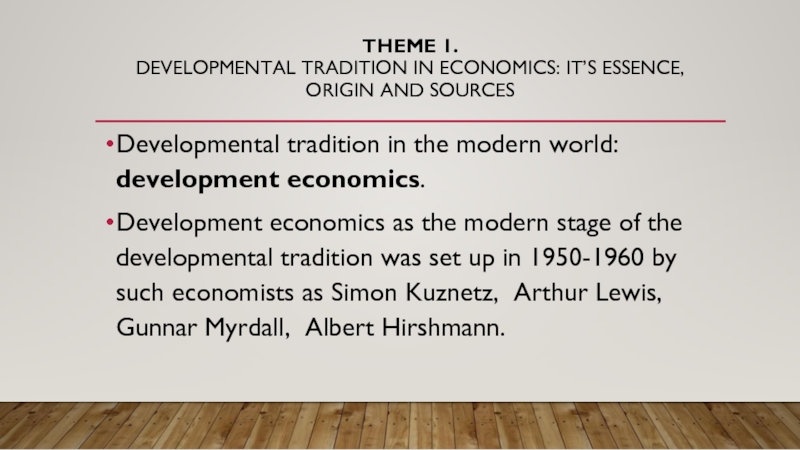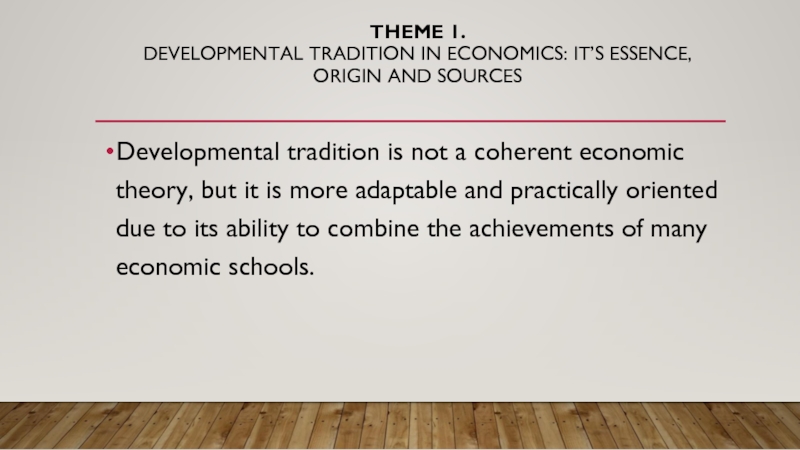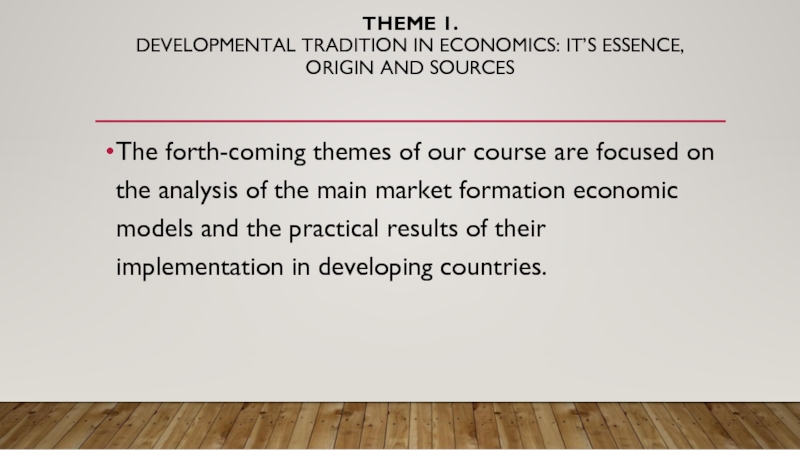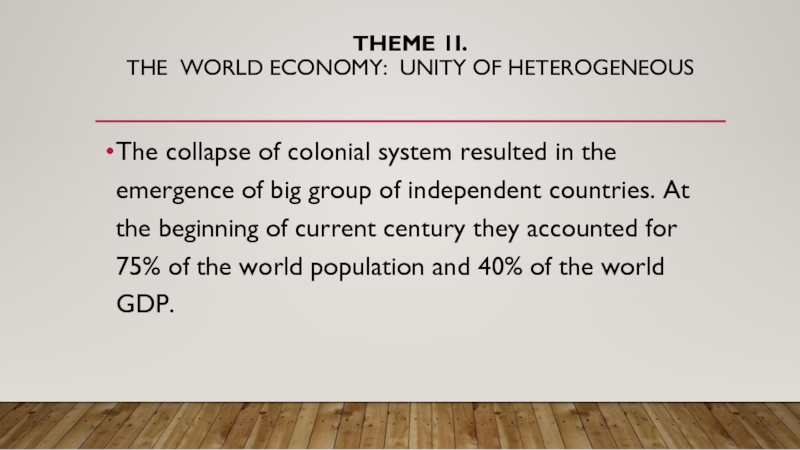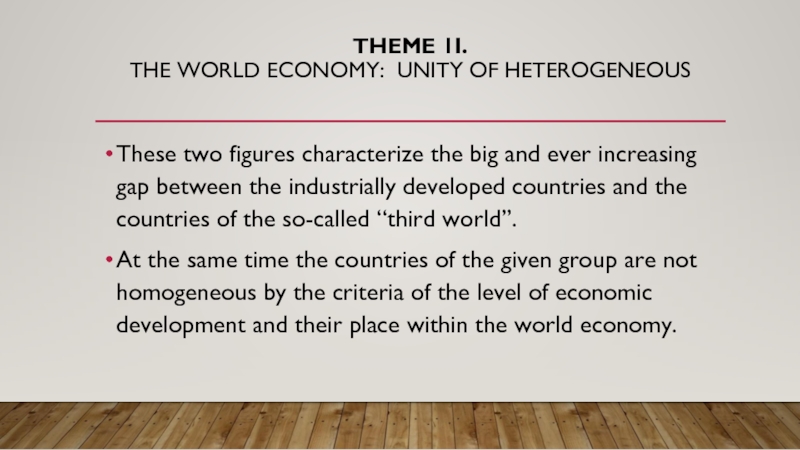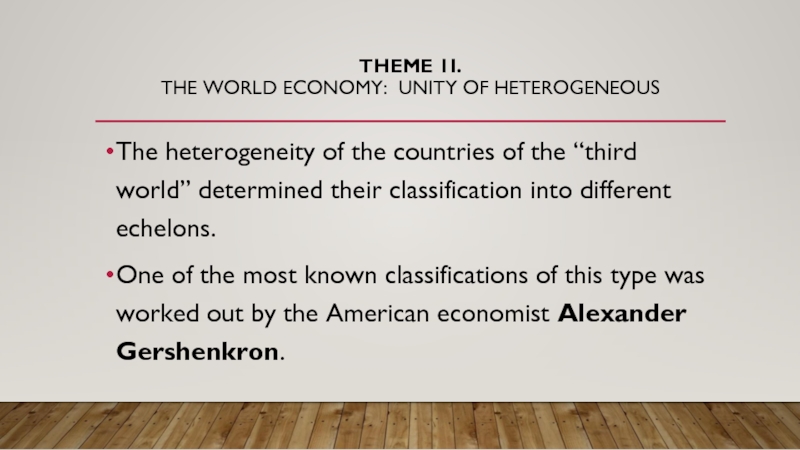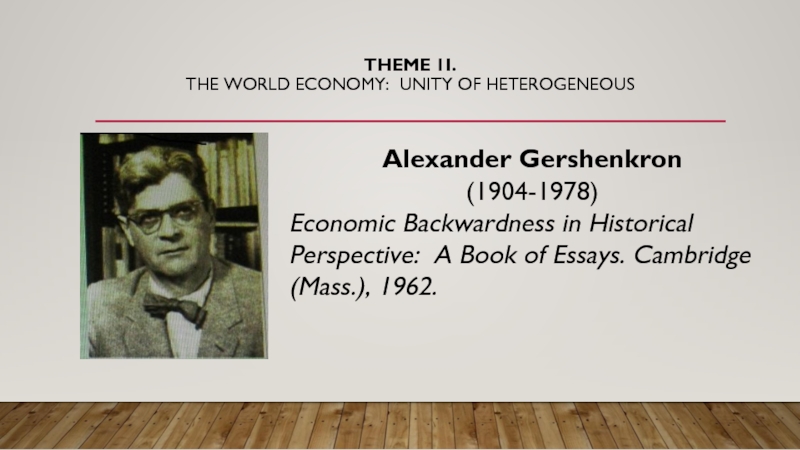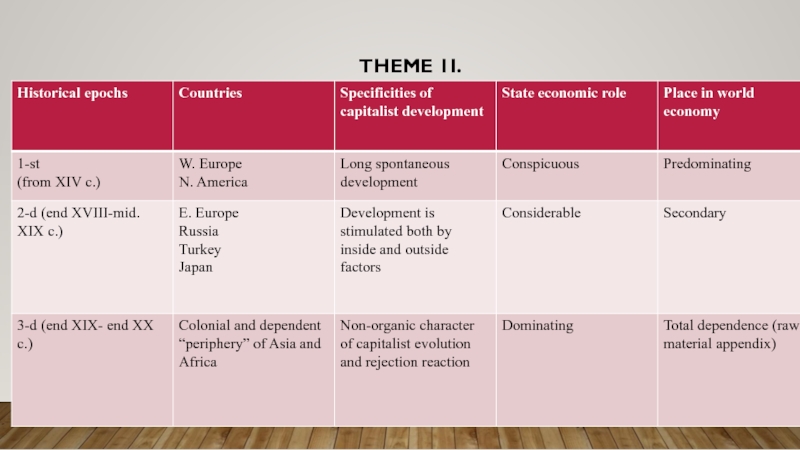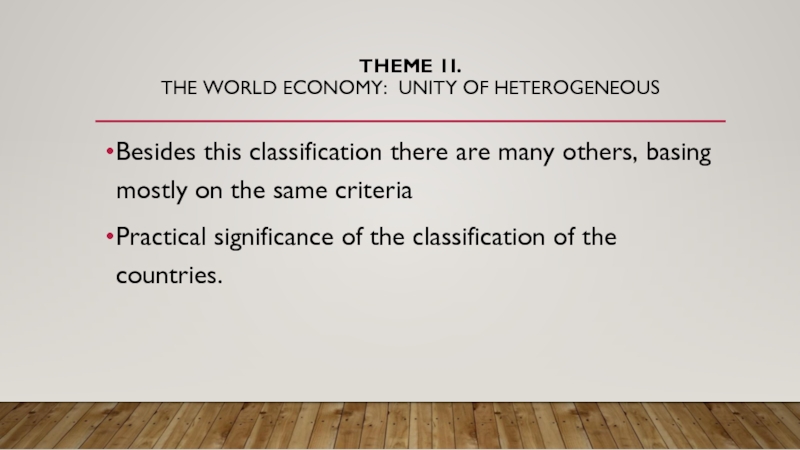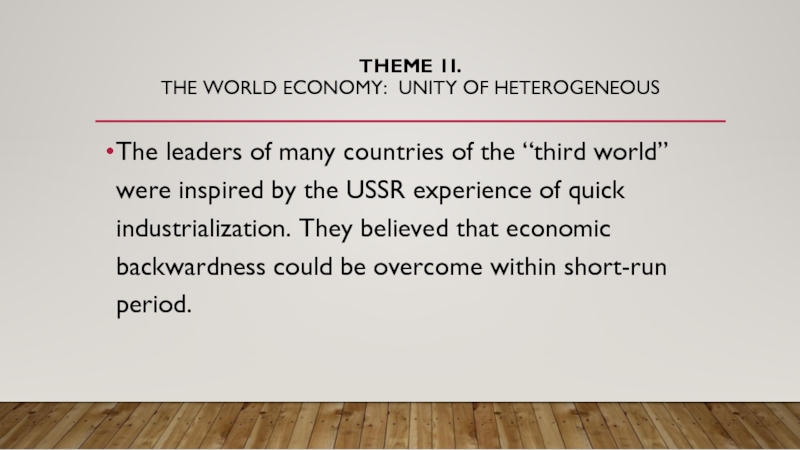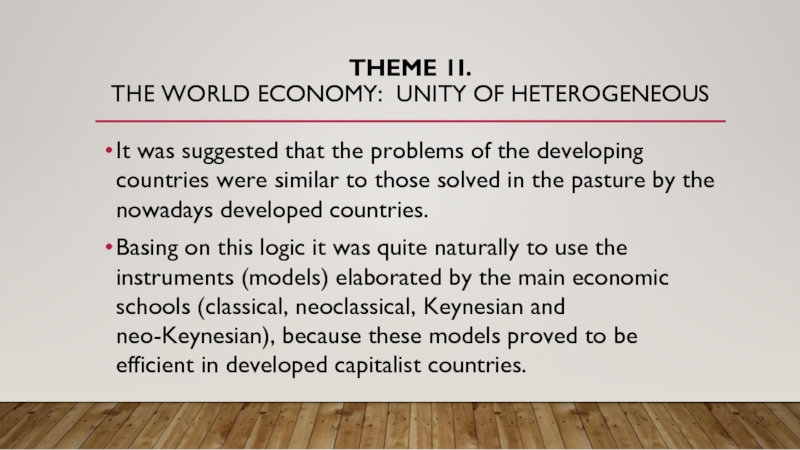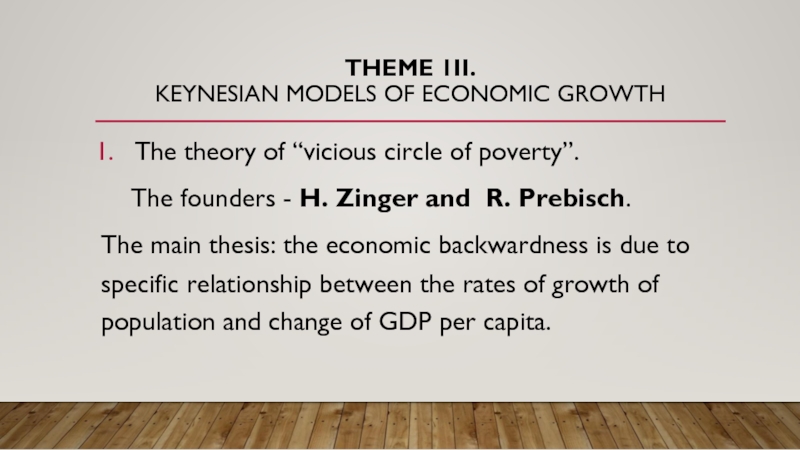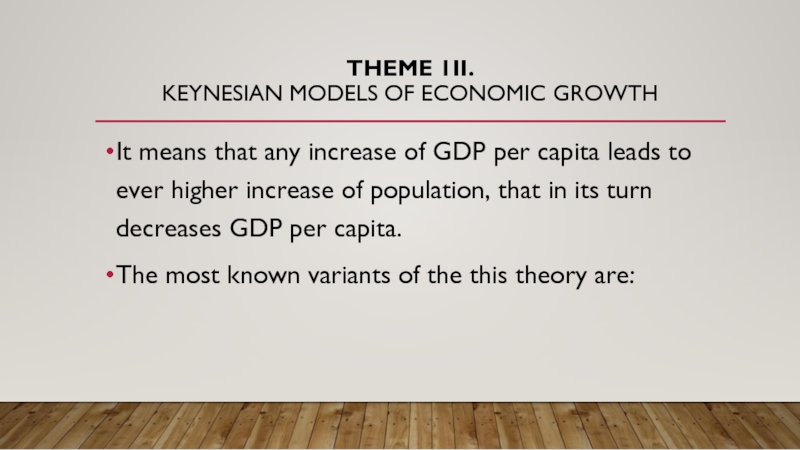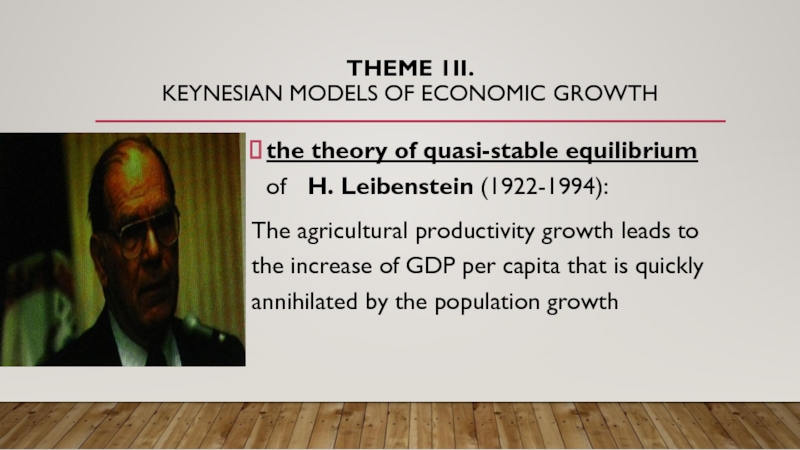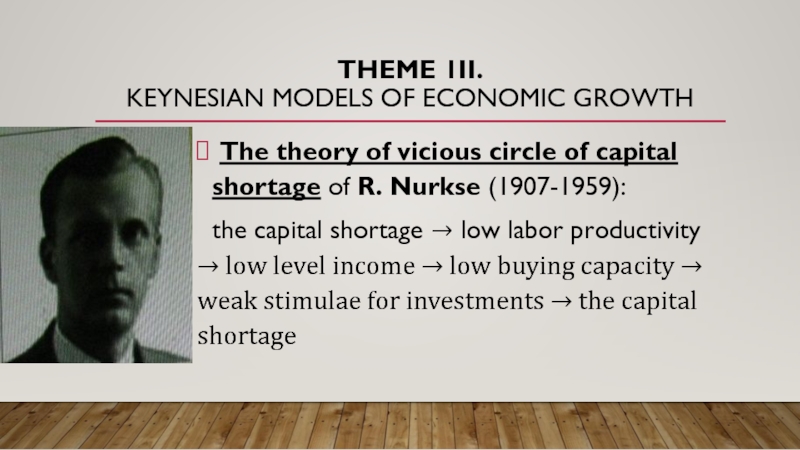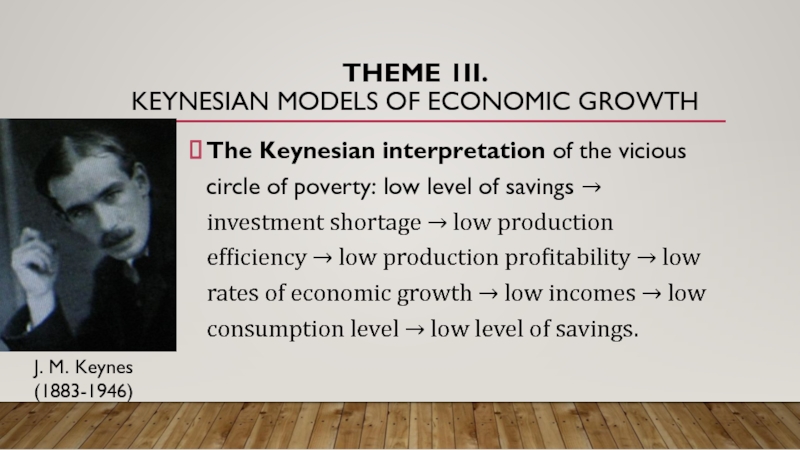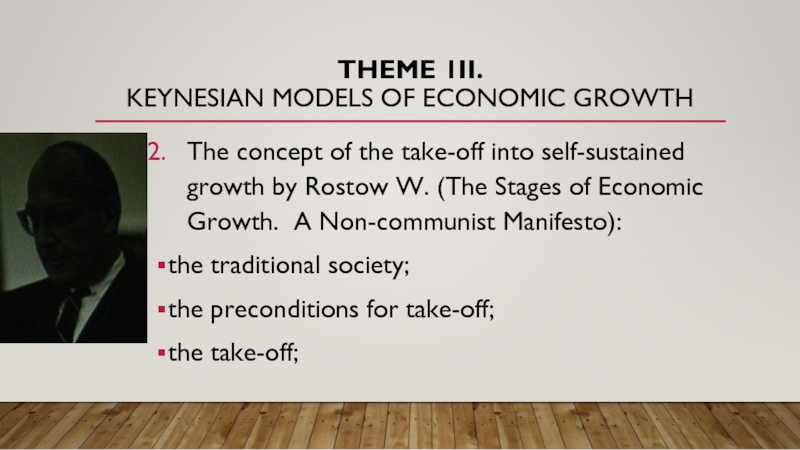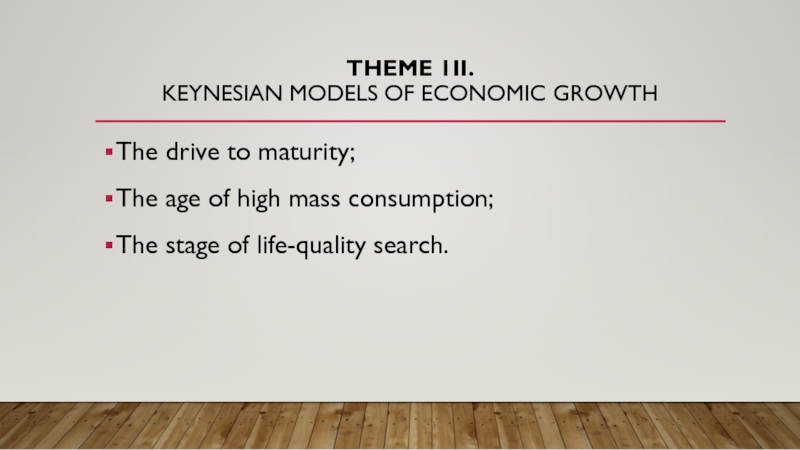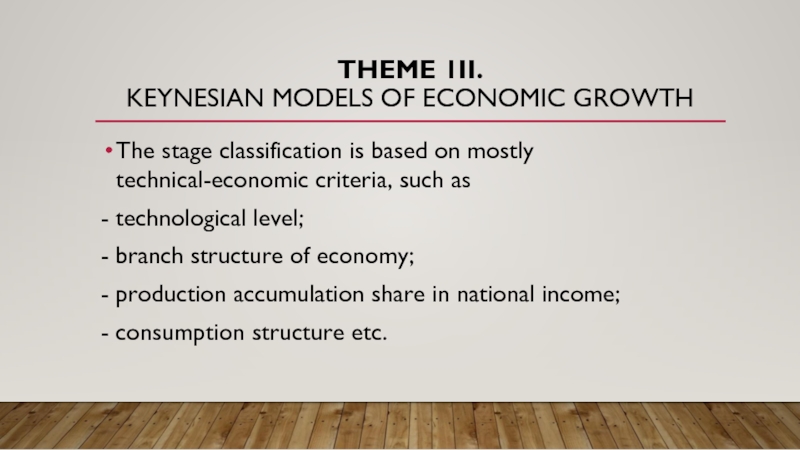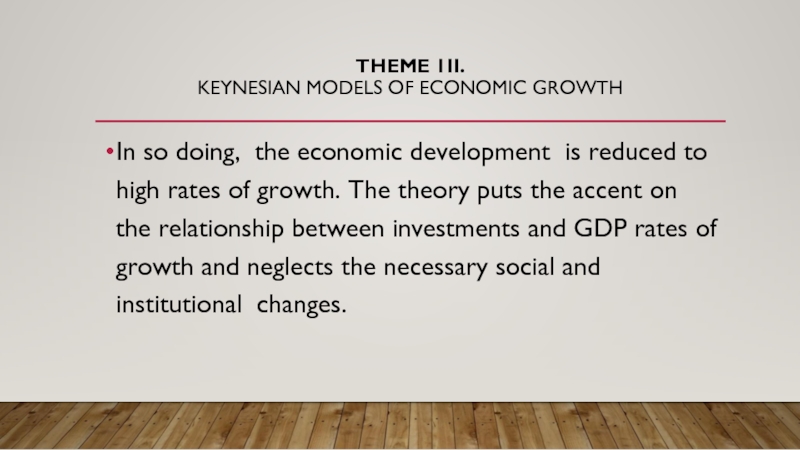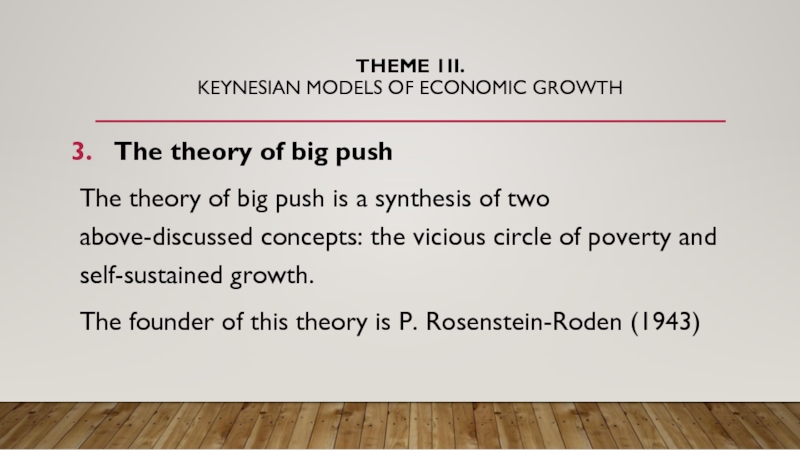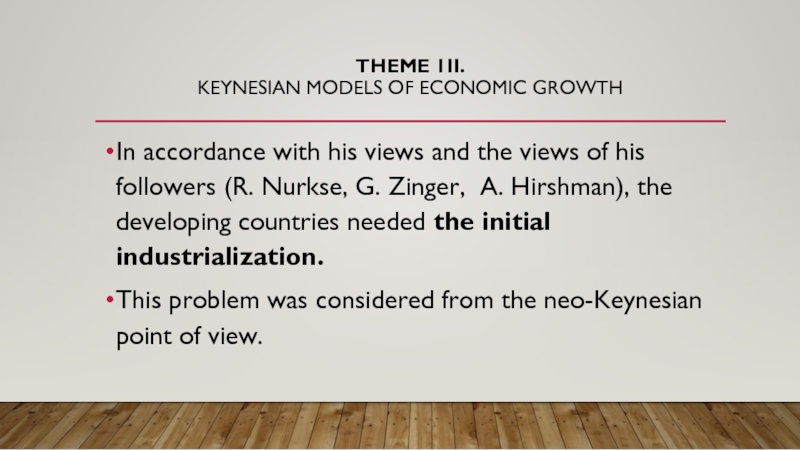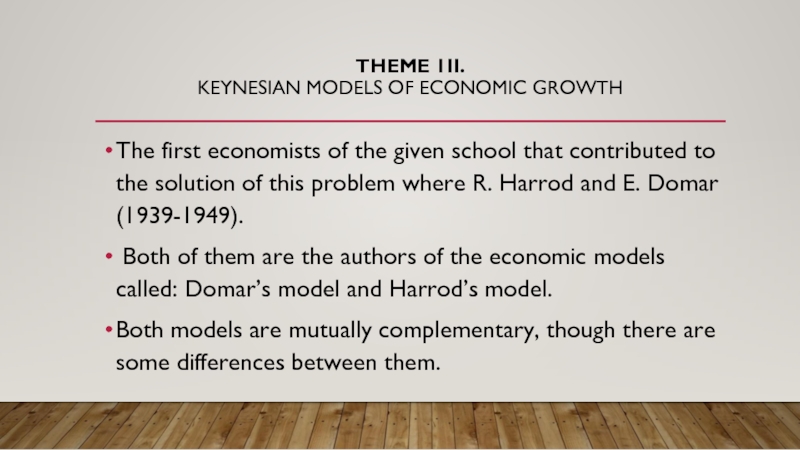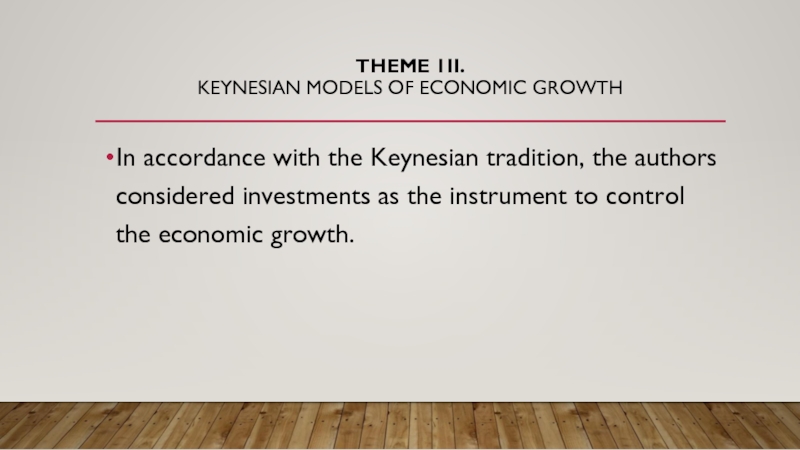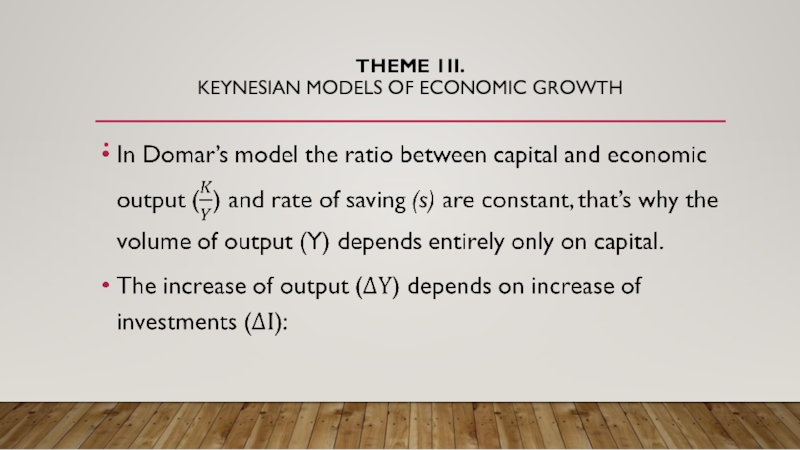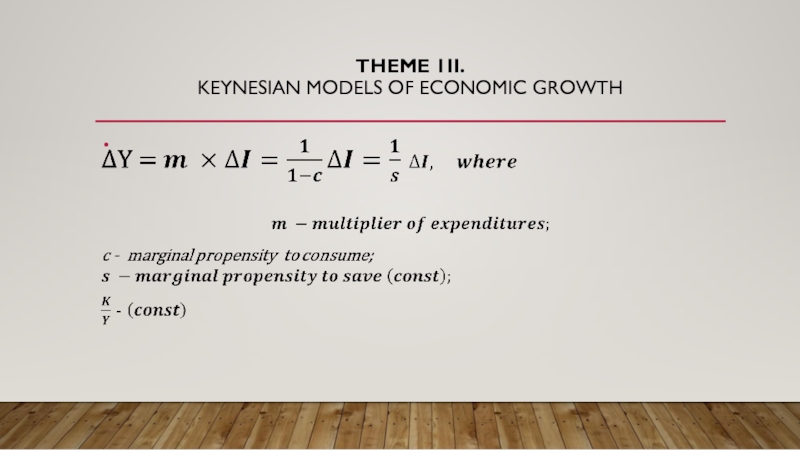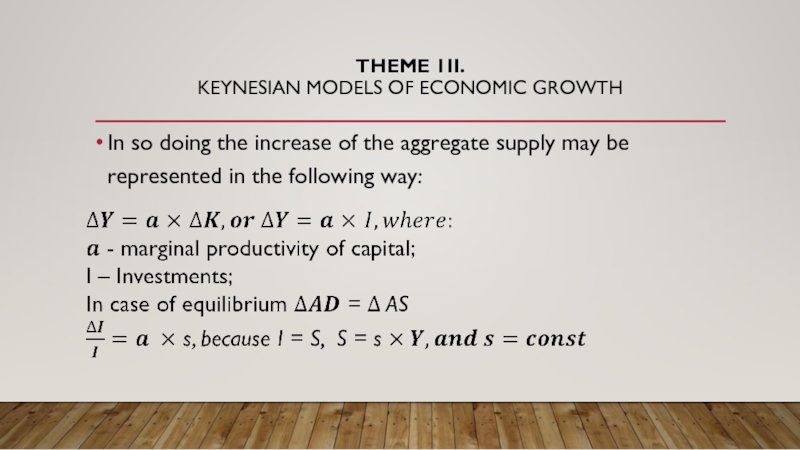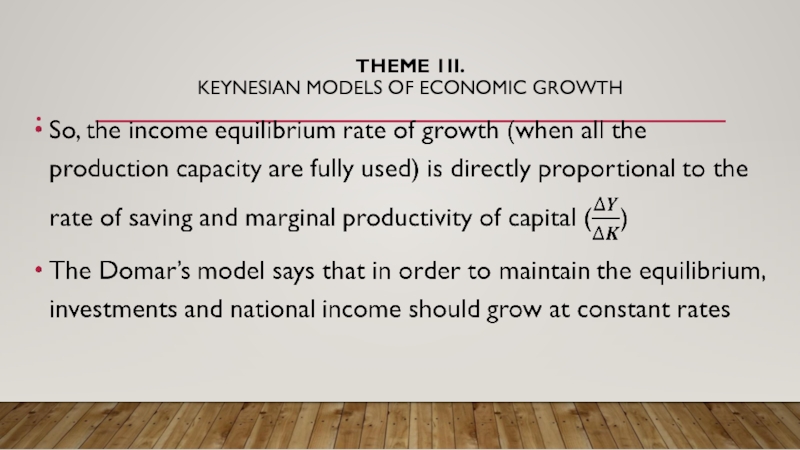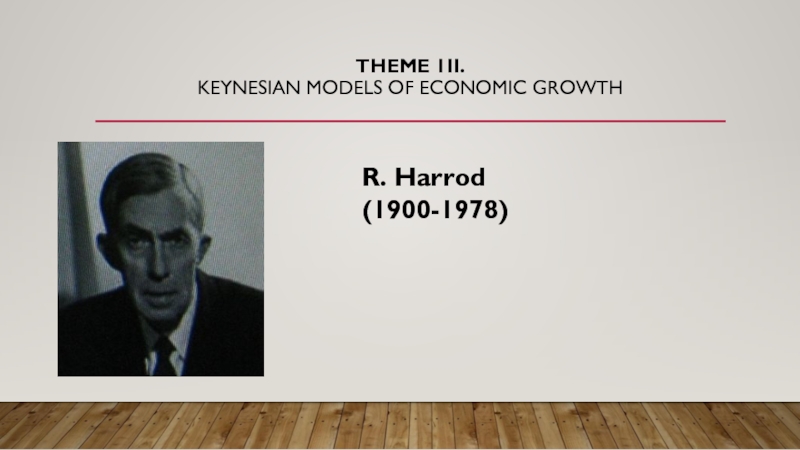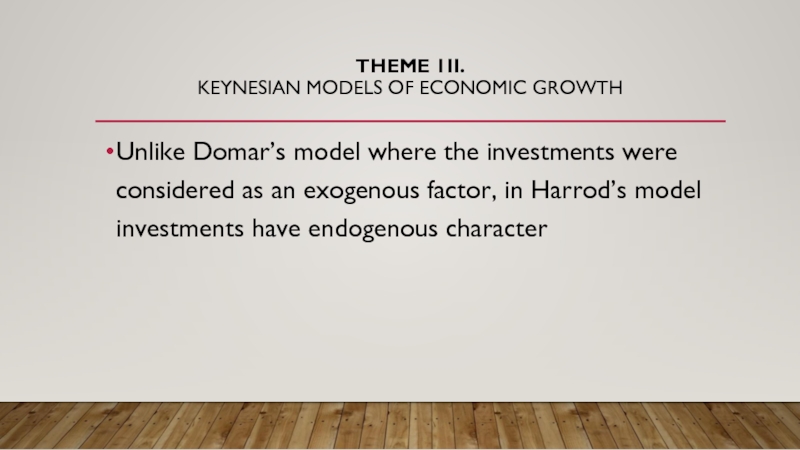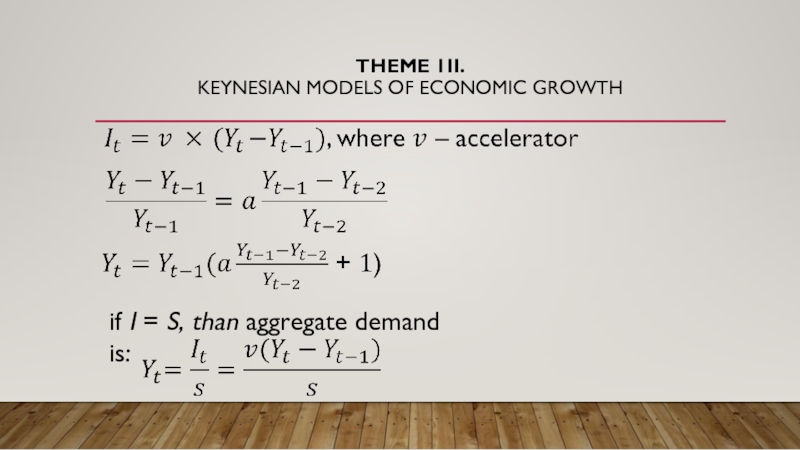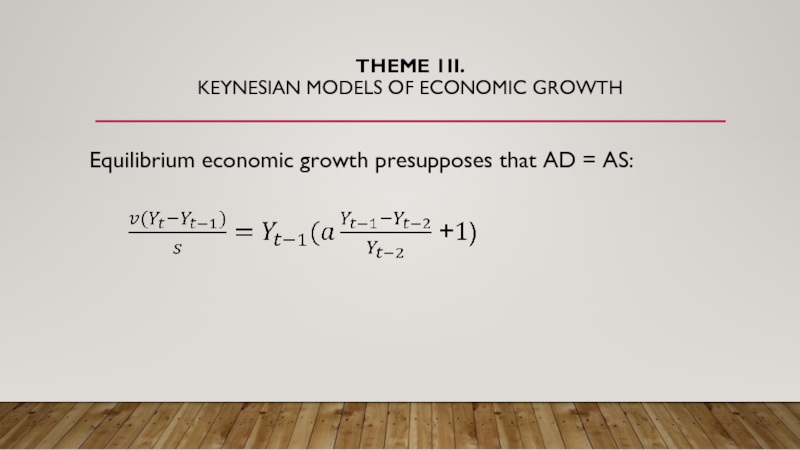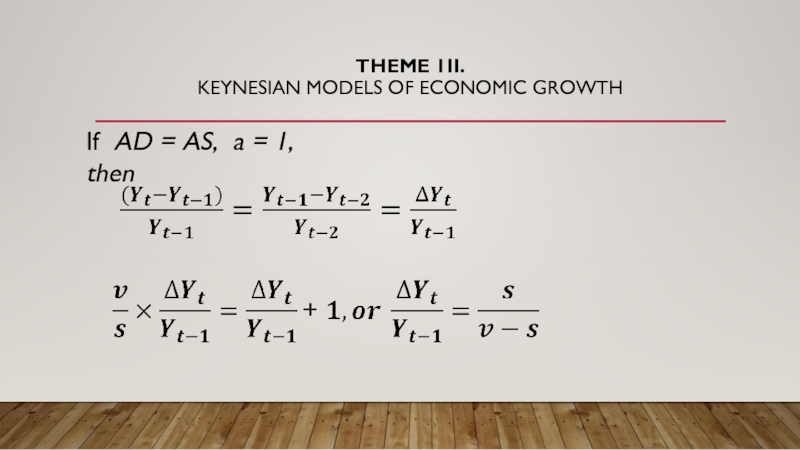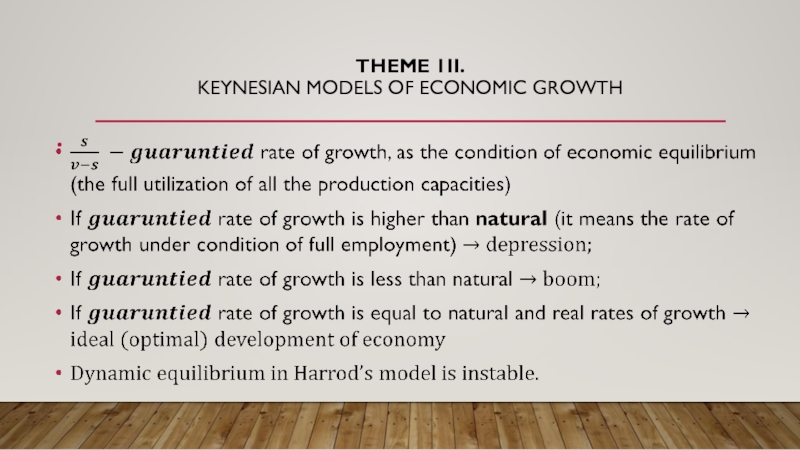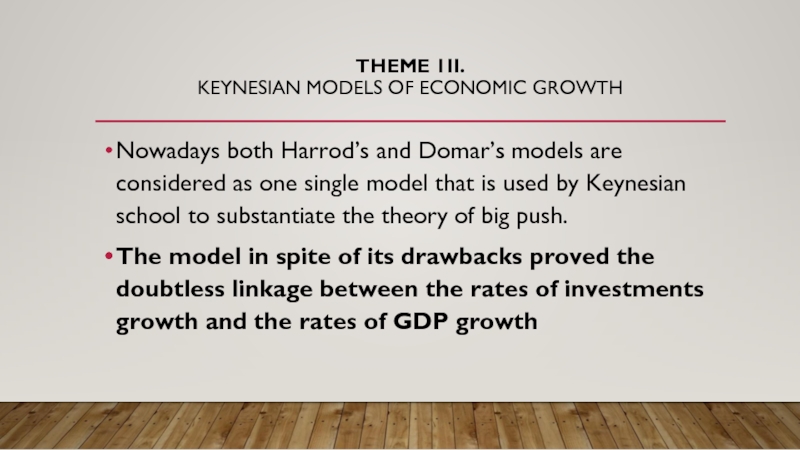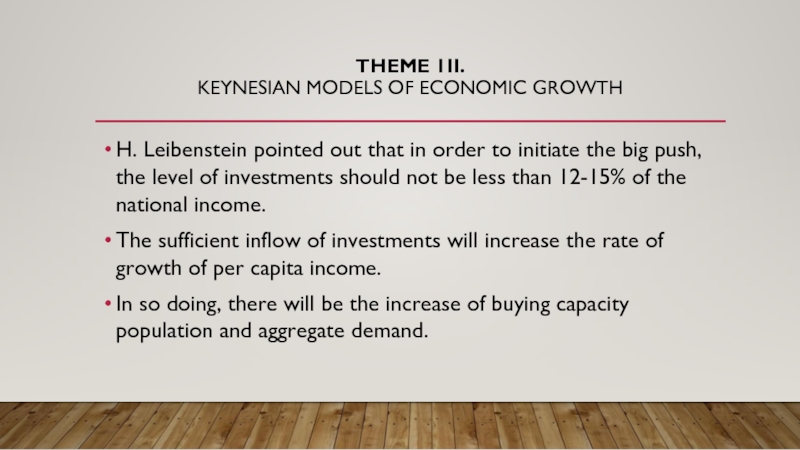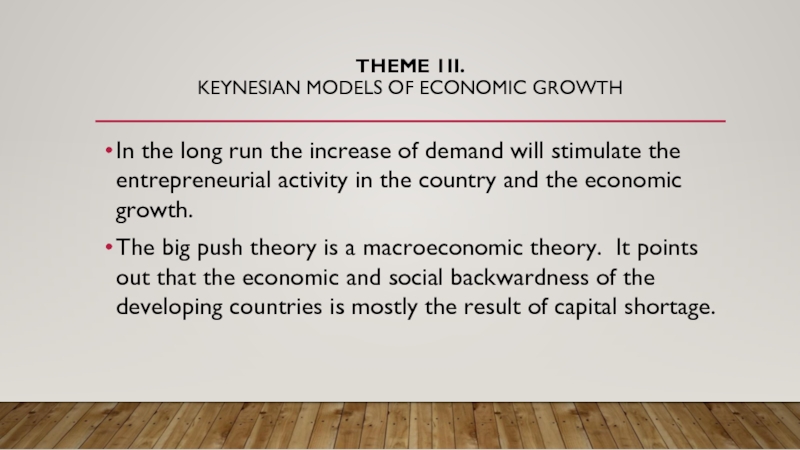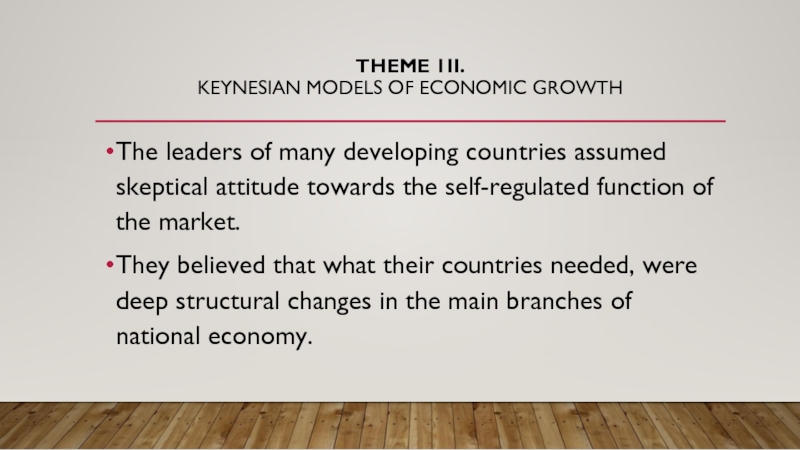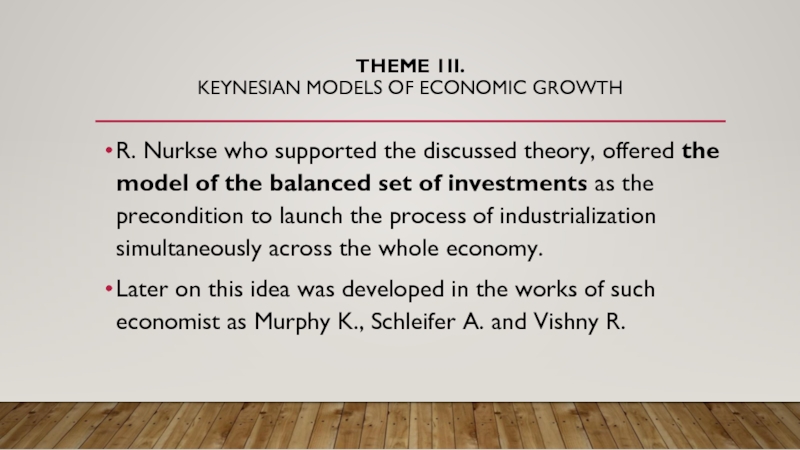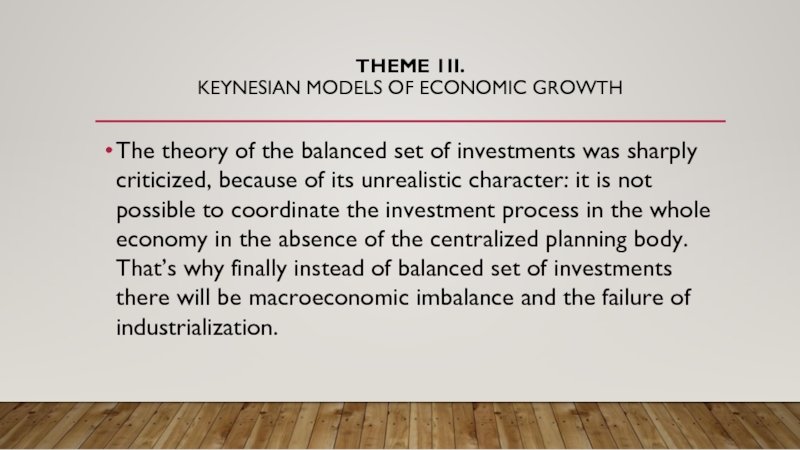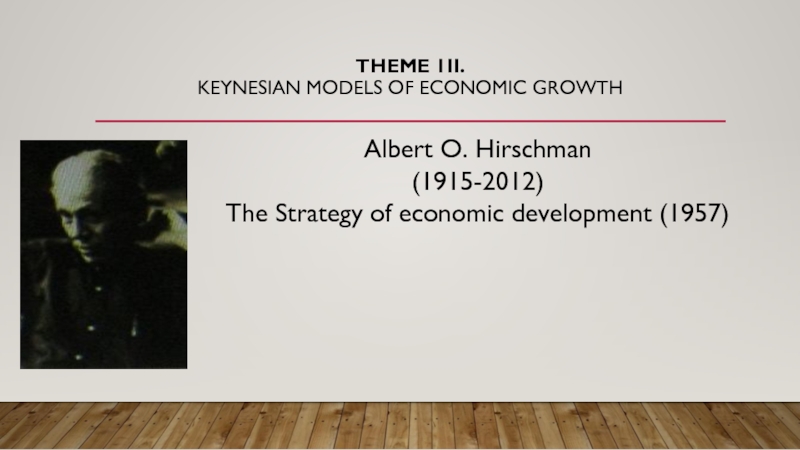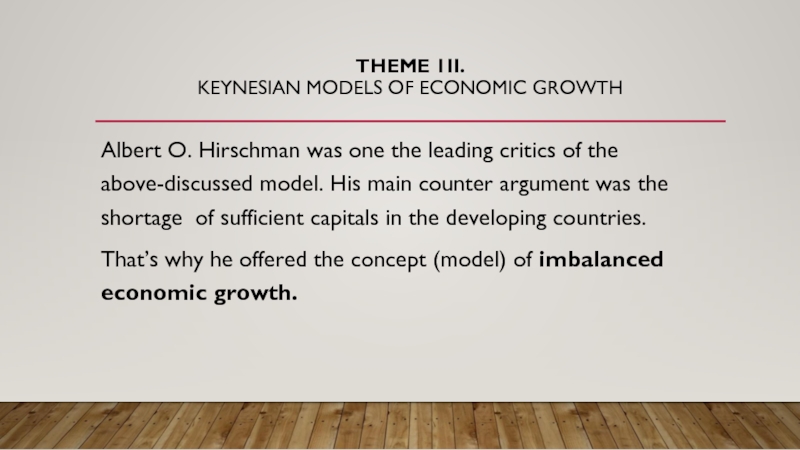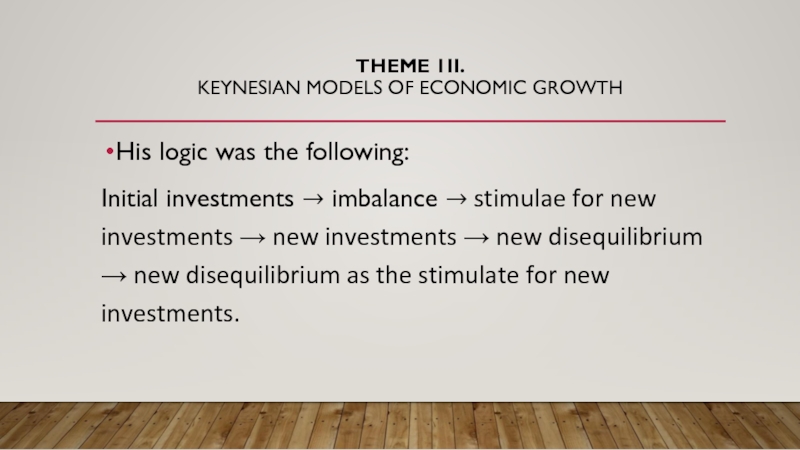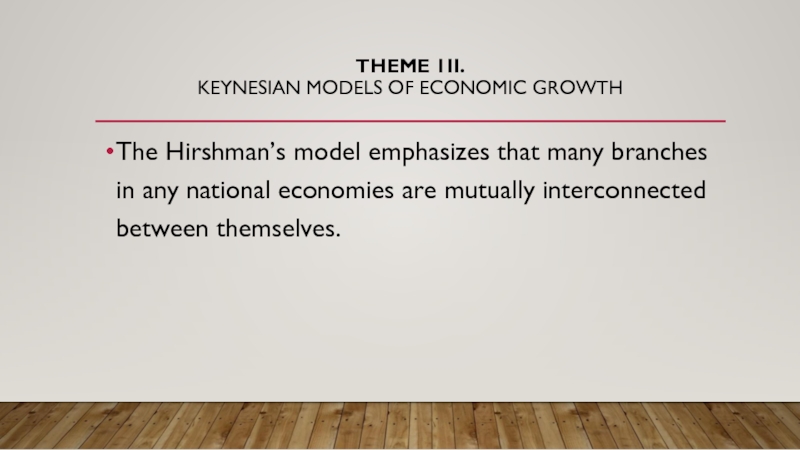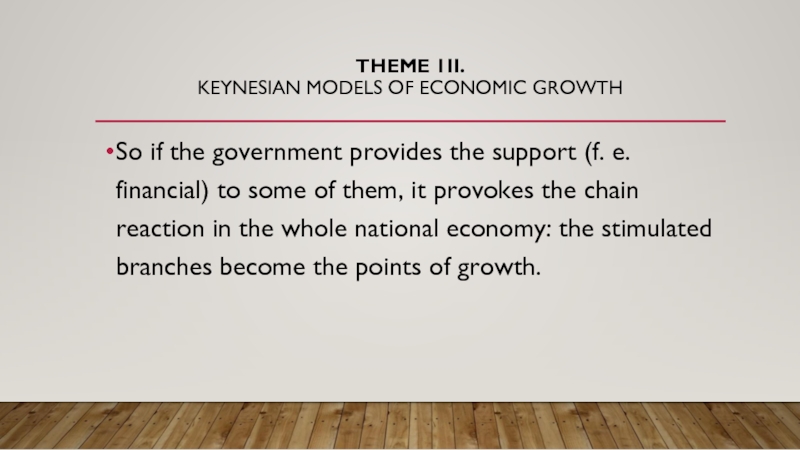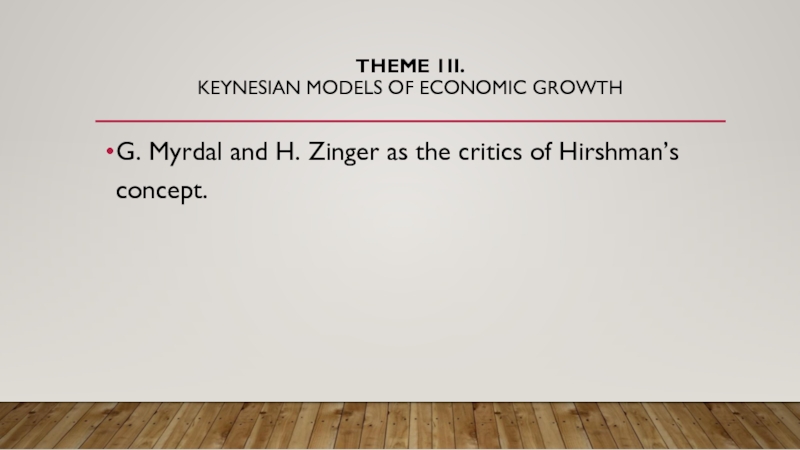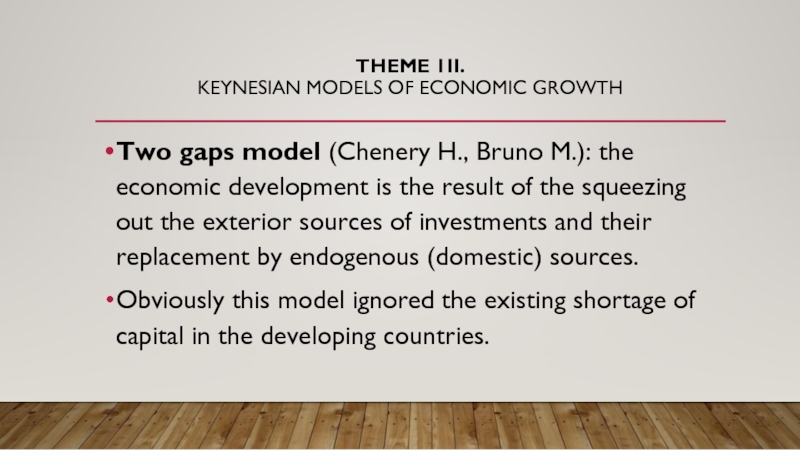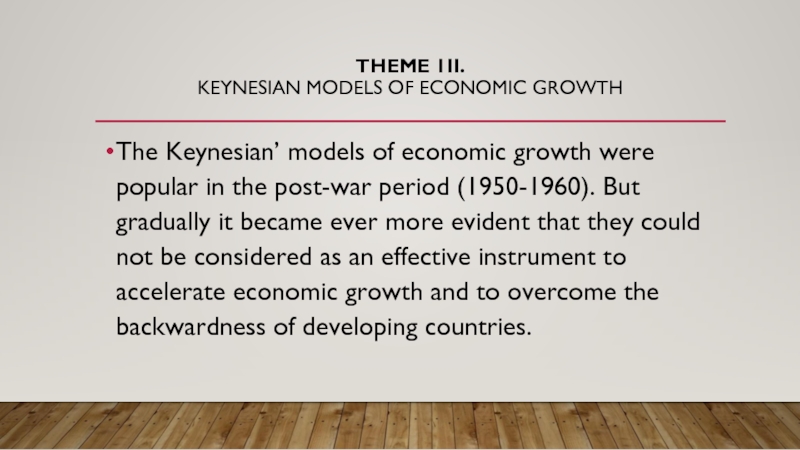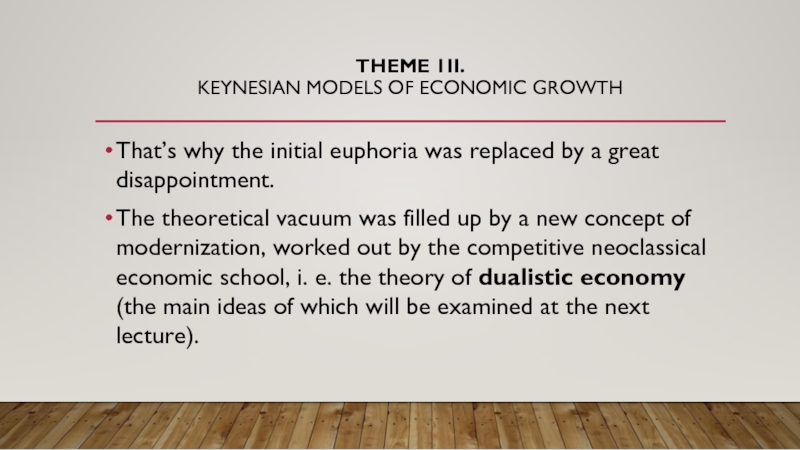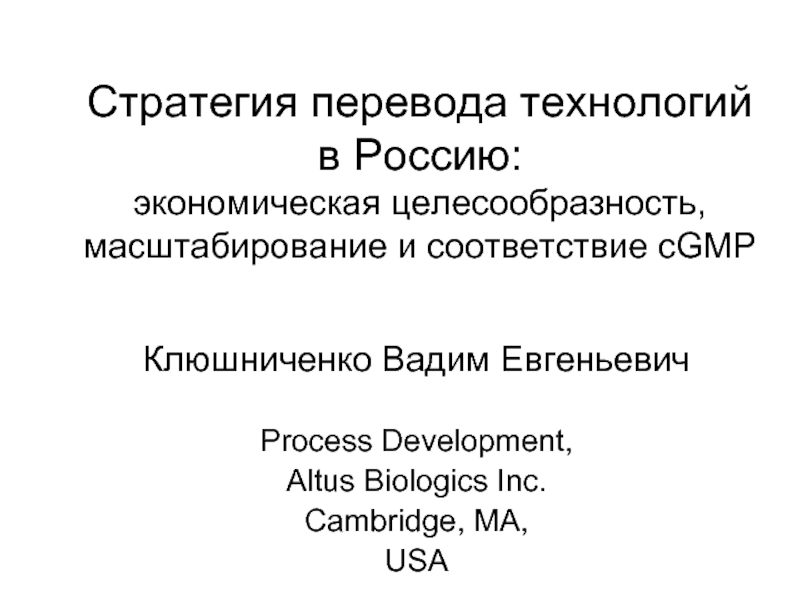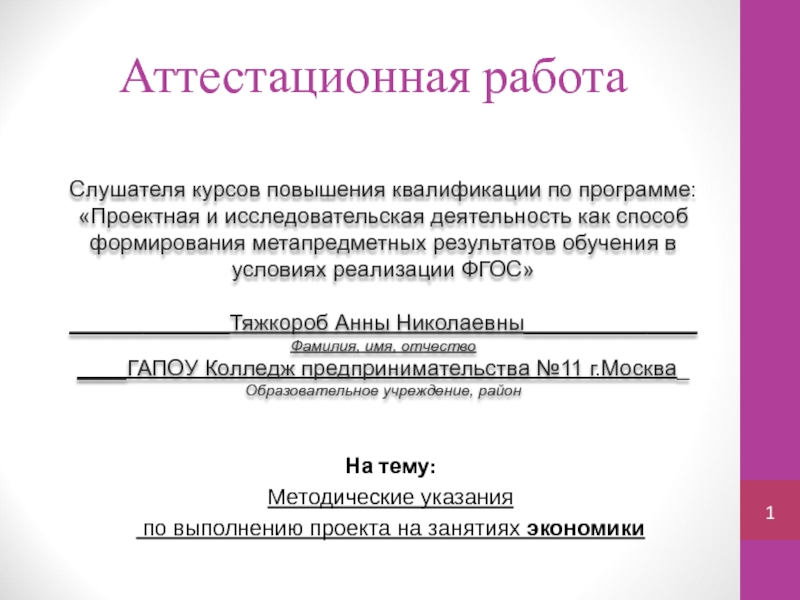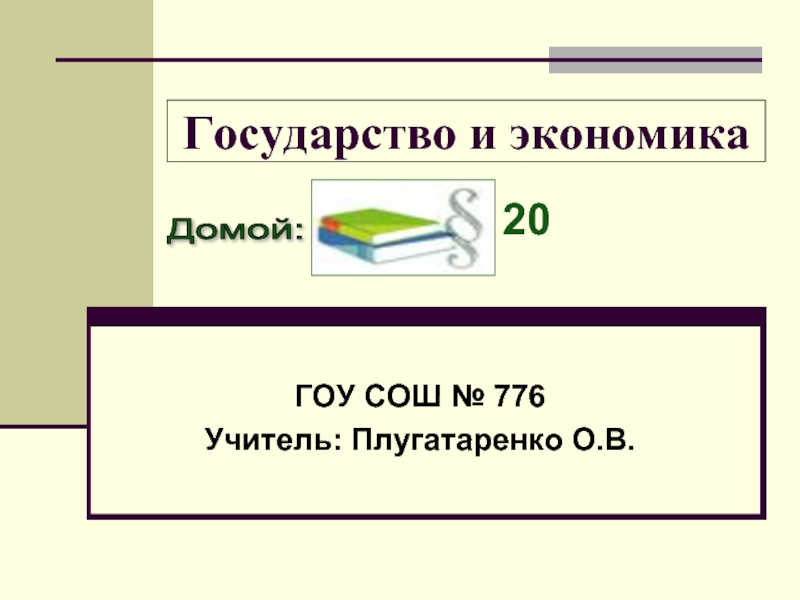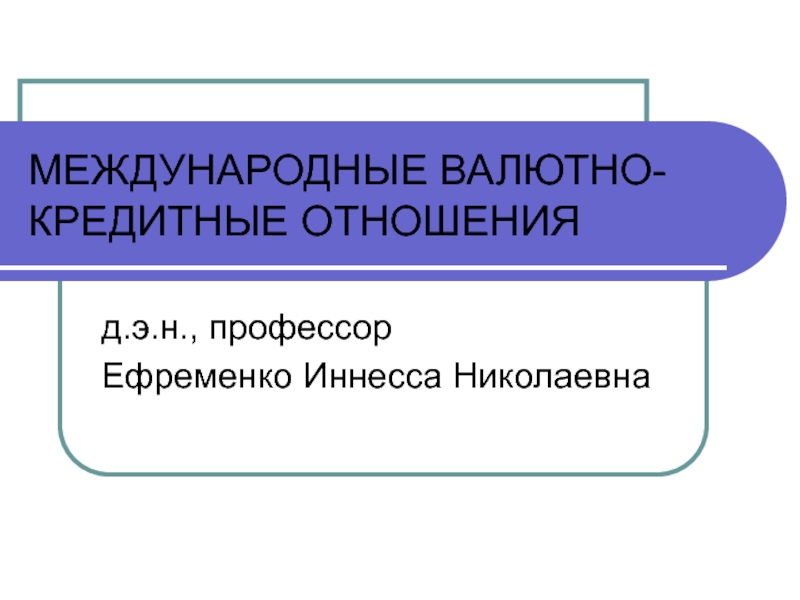- Главная
- Разное
- Дизайн
- Бизнес и предпринимательство
- Аналитика
- Образование
- Развлечения
- Красота и здоровье
- Финансы
- Государство
- Путешествия
- Спорт
- Недвижимость
- Армия
- Графика
- Культурология
- Еда и кулинария
- Лингвистика
- Английский язык
- Астрономия
- Алгебра
- Биология
- География
- Детские презентации
- Информатика
- История
- Литература
- Маркетинг
- Математика
- Медицина
- Менеджмент
- Музыка
- МХК
- Немецкий язык
- ОБЖ
- Обществознание
- Окружающий мир
- Педагогика
- Русский язык
- Технология
- Физика
- Философия
- Химия
- Шаблоны, картинки для презентаций
- Экология
- Экономика
- Юриспруденция
Development economics (market economy formation models) презентация
Содержание
- 1. Development economics (market economy formation models)
- 2. THE STRUCTURE OF THE COURSE Developmental tradition
- 3. THE STRUCTURE OF THE COURSE Neoclassical models
- 4. THE STRUCTURE OF THE COURSE The
- 5. THE STRUCTURE OF THE COURSE Catching-up development
- 6. READING LIST ON THE COURSE Herschenkron
- 7. READING LIST ON THE COURSE Rostow W.
- 8. READING LIST ON THE COURSE Murphy K.,
- 9. READING LIST ON THE COURSE Soto
- 10. THEME 1. DEVELOPMENTAL TRADITION IN ECONOMICS: IT’S
- 11. THEME 1. DEVELOPMENTAL TRADITION IN ECONOMICS: IT’S
- 12. THEME 1. DEVELOPMENTAL TRADITION IN ECONOMICS: IT’S
- 13. THEME 1. DEVELOPMENTAL TRADITION IN ECONOMICS: IT’S
- 14. THEME 1. DEVELOPMENTAL TRADITION IN ECONOMICS: IT’S
- 15. THEME 1. DEVELOPMENTAL TRADITION IN ECONOMICS: IT’S
- 16. THEME 1. DEVELOPMENTAL TRADITION IN ECONOMICS: IT’S
- 17. THEME 1. DEVELOPMENTAL TRADITION IN ECONOMICS: IT’S
- 18. THEME 1I. THE WORLD ECONOMY: UNITY OF
- 19. THEME 1I. THE WORLD ECONOMY: UNITY OF
- 20. THEME 1I. THE WORLD ECONOMY: UNITY OF
- 21. THEME 1I. THE WORLD ECONOMY: UNITY OF
- 22. THEME 1I. THE WORLD ECONOMY: UNITY OF
- 23. THEME 1I.
- 24. THEME 1I. THE WORLD ECONOMY: UNITY OF
- 25. THEME 1I. THE WORLD ECONOMY: UNITY OF
- 26. THEME 1I. THE WORLD ECONOMY: UNITY OF
- 27. THEME 1II. KEYNESIAN MODELS OF ECONOMIC GROWTH
- 28. THEME 1II. KEYNESIAN MODELS OF ECONOMIC GROWTH
- 29. THEME 1II. KEYNESIAN MODELS OF ECONOMIC GROWTH
- 30. THEME 1II. KEYNESIAN MODELS OF ECONOMIC GROWTH
- 31. THEME 1II. KEYNESIAN MODELS OF ECONOMIC GROWTH
- 32. THEME 1II. KEYNESIAN MODELS OF ECONOMIC GROWTH
- 33. THEME 1II. KEYNESIAN MODELS OF ECONOMIC GROWTH
- 34. THEME 1II. KEYNESIAN MODELS OF ECONOMIC GROWTH
- 35. THEME 1II. KEYNESIAN MODELS OF ECONOMIC GROWTH
- 36. THEME 1II. KEYNESIAN MODELS OF ECONOMIC GROWTH
- 37. THEME 1II. KEYNESIAN MODELS OF ECONOMIC GROWTH
- 38. THEME 1II. KEYNESIAN MODELS OF ECONOMIC GROWTH
- 39. THEME 1II. KEYNESIAN MODELS OF ECONOMIC GROWTH
- 40. THEME 1II. KEYNESIAN MODELS OF ECONOMIC GROWTH
- 41. THEME 1II. KEYNESIAN MODELS OF ECONOMIC GROWTH
- 42. THEME 1II. KEYNESIAN MODELS OF ECONOMIC GROWTH
- 43. THEME 1II. KEYNESIAN MODELS OF ECONOMIC GROWTH
- 44. THEME 1II. KEYNESIAN MODELS OF ECONOMIC GROWTH
- 45. THEME 1II. KEYNESIAN MODELS OF ECONOMIC GROWTH
- 46. THEME 1II. KEYNESIAN MODELS OF ECONOMIC GROWTH R. Harrod (1900-1978)
- 47. THEME 1II. KEYNESIAN MODELS OF ECONOMIC GROWTH
- 48. THEME 1II. KEYNESIAN MODELS OF ECONOMIC GROWTH
- 49. THEME 1II. KEYNESIAN MODELS OF ECONOMIC GROWTH
- 50. THEME 1II. KEYNESIAN MODELS OF ECONOMIC GROWTH
- 51. THEME 1II. KEYNESIAN MODELS OF ECONOMIC GROWTH
- 52. THEME 1II. KEYNESIAN MODELS OF ECONOMIC GROWTH
- 53. THEME 1II. KEYNESIAN MODELS OF ECONOMIC GROWTH
- 54. THEME 1II. KEYNESIAN MODELS OF ECONOMIC GROWTH
- 55. THEME 1II. KEYNESIAN MODELS OF ECONOMIC GROWTH
- 56. THEME 1II. KEYNESIAN MODELS OF ECONOMIC GROWTH
- 57. THEME 1II. KEYNESIAN MODELS OF ECONOMIC GROWTH
- 58. THEME 1II. KEYNESIAN MODELS OF ECONOMIC GROWTH
- 59. THEME 1II. KEYNESIAN MODELS OF ECONOMIC GROWTH
- 60. THEME 1II. KEYNESIAN MODELS OF ECONOMIC GROWTH
- 61. THEME 1II. KEYNESIAN MODELS OF ECONOMIC GROWTH
- 62. THEME 1II. KEYNESIAN MODELS OF ECONOMIC GROWTH
- 63. THEME 1II. KEYNESIAN MODELS OF ECONOMIC GROWTH
- 64. THEME 1II. KEYNESIAN MODELS OF ECONOMIC GROWTH
- 65. THEME 1II. KEYNESIAN MODELS OF ECONOMIC GROWTH
- 66. THEME 1II. KEYNESIAN MODELS OF ECONOMIC GROWTH
- 67. THEME 1II. KEYNESIAN MODELS OF ECONOMIC GROWTH
Слайд 2THE STRUCTURE OF THE COURSE
Developmental tradition in Economics: it’s essence, origin
and sources.
The world economy: unity of heterogeneous.
Keynesian models of economic growth.
The world economy: unity of heterogeneous.
Keynesian models of economic growth.
Слайд 3THE STRUCTURE OF THE COURSE
Neoclassical models of economic development.
Institutional and neo-institutional
analysis of the problems of economic modernization.
The exterior factors of economic development: their essence, types and role.
The exterior factors of economic development: their essence, types and role.
Слайд 4THE STRUCTURE OF THE COURSE
The new models of economic growth
on the role of human capital.
Factor markets and the problem of poverty in developing countries.
Government and market: the problems of their interaction in developing countries.
Factor markets and the problem of poverty in developing countries.
Government and market: the problems of their interaction in developing countries.
Слайд 5THE STRUCTURE OF THE COURSE
Catching-up development in the modern world: the
factors, results and problems.
Market reforms in Russia: short history, results and problems.
Market reforms in Russia: short history, results and problems.
Слайд 6
READING LIST ON THE COURSE
Herschenkron A. Economic Backwardness in Historical Perspective:
A Book of Essays. Cambridge (Mass.), 1962.
Preston P. W. Theories of Development. L., 1982.
Coleman D., Nixson F. Economics of Change in Less Developed Countries. 2nd ed. Oxfard 1986
Rostow W. W. Theories of Economics Growth from David Hume to the Present. N.Y., 1992.
Preston P. W. Theories of Development. L., 1982.
Coleman D., Nixson F. Economics of Change in Less Developed Countries. 2nd ed. Oxfard 1986
Rostow W. W. Theories of Economics Growth from David Hume to the Present. N.Y., 1992.
Слайд 7READING LIST ON THE COURSE
Rostow W. W. The Stages of Economics
Growth. A Non-communist Manifesto. Cambridge, 1960.
Leibenstein H. A. Economic Backwardness and Economic Growth. Studies in the Theory of Economic Development. N.Y., 1957.
Todaro M. P. Economic Development. 5th ed. L., 1994.
Ray D. Development Economics. Princeton, 1998.
Rosenstein-Rodan P. N. Problems of Industrialization of Eastern and South-Estern Europe // The Economic Journal. 1943. Vol. 53. June/ September.
Leibenstein H. A. Economic Backwardness and Economic Growth. Studies in the Theory of Economic Development. N.Y., 1957.
Todaro M. P. Economic Development. 5th ed. L., 1994.
Ray D. Development Economics. Princeton, 1998.
Rosenstein-Rodan P. N. Problems of Industrialization of Eastern and South-Estern Europe // The Economic Journal. 1943. Vol. 53. June/ September.
Слайд 8READING LIST ON THE COURSE
Murphy K., Schleifer A., Vishny R. Industrialization
and the Big Push // Journal of Political Economy. 1989.
Hirshman A.O. The Strategy of Economic Development. 2nd ed. New Haven, 1961.
Lewis W. A. The Theory of Economic Growth. N.Y., 1959.
Myrdal G. Asian Drama: An Inquiry into the Poverty of Nations. Vol. I-III. N.Y., 1968.
Schultez T.W. Investments in Human Capital. N.Y., 1971.
Soto E. de. The Mystery of Capital. N.Y., 1995.
Hirshman A.O. The Strategy of Economic Development. 2nd ed. New Haven, 1961.
Lewis W. A. The Theory of Economic Growth. N.Y., 1959.
Myrdal G. Asian Drama: An Inquiry into the Poverty of Nations. Vol. I-III. N.Y., 1968.
Schultez T.W. Investments in Human Capital. N.Y., 1971.
Soto E. de. The Mystery of Capital. N.Y., 1995.
Слайд 9READING LIST ON THE COURSE
Soto E. de. The Other Way. N.Y.,
1987.
Prebisch R. The Economic Development of Latin America and Its Principal Problems. N.Y. 1962.
Amin S. L’échange inégale et la loi de la valeur. Paris. 1973.
Solow R. A Contribution to the Theory of Economic Growth//.Quarterly journal of Economics. 1956. February.
Becker G. Human Capital. N.Y. 1954.
Ha-Joan Chang Economics: the User’s Guide. London, Penguin Books, 2010.
Нуреев Р.М. Экономика развития: модели становления рыночной экономики. Изд. Норма, М., 2008.
Prebisch R. The Economic Development of Latin America and Its Principal Problems. N.Y. 1962.
Amin S. L’échange inégale et la loi de la valeur. Paris. 1973.
Solow R. A Contribution to the Theory of Economic Growth//.Quarterly journal of Economics. 1956. February.
Becker G. Human Capital. N.Y. 1954.
Ha-Joan Chang Economics: the User’s Guide. London, Penguin Books, 2010.
Нуреев Р.М. Экономика развития: модели становления рыночной экономики. Изд. Норма, М., 2008.
Слайд 10THEME 1.
DEVELOPMENTAL TRADITION IN ECONOMICS: IT’S ESSENCE, ORIGIN AND SOURCES
Backward countries
can not develop if they entirely rely on the market
Path dependence problem
Development tradition is not an economic school: pragmatic and eclectic character, but its eclecticism is at the same time its drawback and advantage.
Path dependence problem
Development tradition is not an economic school: pragmatic and eclectic character, but its eclecticism is at the same time its drawback and advantage.
Слайд 11THEME 1.
DEVELOPMENTAL TRADITION IN ECONOMICS: IT’S ESSENCE, ORIGIN AND SOURCES
Developmental tradition
is the most important intellectual tradition in Economics: it accounts for all the successful examples of economic development in the history of mankind (GB, the USA, Germany, the modern China).
Слайд 12THEME 1.
DEVELOPMENTAL TRADITION IN ECONOMICS: IT’S ESSENCE, ORIGIN AND SOURCES
Developmental tradition:
its origin and evolution (Henry VII, Govanni Botero, Antonio Serre, mercantilist economic school, German historical school).
Development tradition had for its goal to assist the economically backward countries to develop their economies in order to catch up the economically advanced countries.
Development tradition had for its goal to assist the economically backward countries to develop their economies in order to catch up the economically advanced countries.
Слайд 13THEME 1.
DEVELOPMENTAL TRADITION IN ECONOMICS: IT’S ESSENCE, ORIGIN AND SOURCES
The followers
of the developmental tradition believed that economic development can not be reduced entirely to income maximization (the richness in natural resources may be sufficient for it).
They considered the economic development as the result of the ever more productive capacities growth.
They considered the economic development as the result of the ever more productive capacities growth.
Слайд 14THEME 1.
DEVELOPMENTAL TRADITION IN ECONOMICS: IT’S ESSENCE, ORIGIN AND SOURCES
The followers
of the developmental tradition pointed out that the above-mentioned task can not be solved without an active state economic policy under respective forms.
Слайд 15THEME 1.
DEVELOPMENTAL TRADITION IN ECONOMICS: IT’S ESSENCE, ORIGIN AND SOURCES
Developmental tradition
in the modern world: development economics.
Development economics as the modern stage of the developmental tradition was set up in 1950-1960 by such economists as Simon Kuznetz, Arthur Lewis, Gunnar Myrdall, Albert Hirshmann.
Development economics as the modern stage of the developmental tradition was set up in 1950-1960 by such economists as Simon Kuznetz, Arthur Lewis, Gunnar Myrdall, Albert Hirshmann.
Слайд 16THEME 1.
DEVELOPMENTAL TRADITION IN ECONOMICS: IT’S ESSENCE, ORIGIN AND SOURCES
Developmental tradition
is not a coherent economic theory, but it is more adaptable and practically oriented due to its ability to combine the achievements of many economic schools.
Слайд 17THEME 1.
DEVELOPMENTAL TRADITION IN ECONOMICS: IT’S ESSENCE, ORIGIN AND SOURCES
The forth-coming
themes of our course are focused on the analysis of the main market formation economic models and the practical results of their implementation in developing countries.
Слайд 18THEME 1I.
THE WORLD ECONOMY: UNITY OF HETEROGENEOUS
The collapse of colonial system
resulted in the emergence of big group of independent countries. At the beginning of current century they accounted for 75% of the world population and 40% of the world GDP.
Слайд 19THEME 1I.
THE WORLD ECONOMY: UNITY OF HETEROGENEOUS
These two figures characterize the
big and ever increasing gap between the industrially developed countries and the countries of the so-called “third world”.
At the same time the countries of the given group are not homogeneous by the criteria of the level of economic development and their place within the world economy.
At the same time the countries of the given group are not homogeneous by the criteria of the level of economic development and their place within the world economy.
Слайд 20THEME 1I.
THE WORLD ECONOMY: UNITY OF HETEROGENEOUS
The heterogeneity of the countries
of the “third world” determined their classification into different echelons.
One of the most known classifications of this type was worked out by the American economist Alexander Gershenkron.
One of the most known classifications of this type was worked out by the American economist Alexander Gershenkron.
Слайд 21THEME 1I.
THE WORLD ECONOMY: UNITY OF HETEROGENEOUS
Alexander Gershenkron
(1904-1978)
Economic Backwardness in
Historical Perspective: A Book of Essays. Cambridge (Mass.), 1962.
Слайд 22THEME 1I.
THE WORLD ECONOMY: UNITY OF HETEROGENEOUS
A. Gershenkron divided all the
capitalist countries into three echelons (see the next slide):
Слайд 24THEME 1I.
THE WORLD ECONOMY: UNITY OF HETEROGENEOUS
Besides this classification there are
many others, basing mostly on the same criteria
Practical significance of the classification of the countries.
Practical significance of the classification of the countries.
Слайд 25THEME 1I.
THE WORLD ECONOMY: UNITY OF HETEROGENEOUS
The leaders of many countries
of the “third world” were inspired by the USSR experience of quick industrialization. They believed that economic backwardness could be overcome within short-run period.
Слайд 26THEME 1I.
THE WORLD ECONOMY: UNITY OF HETEROGENEOUS
It was suggested that the
problems of the developing countries were similar to those solved in the pasture by the nowadays developed countries.
Basing on this logic it was quite naturally to use the instruments (models) elaborated by the main economic schools (classical, neoclassical, Keynesian and neo-Keynesian), because these models proved to be efficient in developed capitalist countries.
Basing on this logic it was quite naturally to use the instruments (models) elaborated by the main economic schools (classical, neoclassical, Keynesian and neo-Keynesian), because these models proved to be efficient in developed capitalist countries.
Слайд 27THEME 1II.
KEYNESIAN MODELS OF ECONOMIC GROWTH
The theory of “vicious circle of
poverty”.
The founders - H. Zinger and R. Prebisch.
The main thesis: the economic backwardness is due to specific relationship between the rates of growth of population and change of GDP per capita.
The founders - H. Zinger and R. Prebisch.
The main thesis: the economic backwardness is due to specific relationship between the rates of growth of population and change of GDP per capita.
Слайд 28THEME 1II.
KEYNESIAN MODELS OF ECONOMIC GROWTH
It means that any increase of
GDP per capita leads to ever higher increase of population, that in its turn decreases GDP per capita.
The most known variants of the this theory are:
The most known variants of the this theory are:
Слайд 29THEME 1II.
KEYNESIAN MODELS OF ECONOMIC GROWTH
the theory of quasi-stable equilibrium of
H. Leibenstein (1922-1994):
The agricultural productivity growth leads to the increase of GDP per capita that is quickly annihilated by the population growth
The agricultural productivity growth leads to the increase of GDP per capita that is quickly annihilated by the population growth
Слайд 30THEME 1II.
KEYNESIAN MODELS OF ECONOMIC GROWTH
The theory of vicious circle
of capital shortage of R. Nurkse (1907-1959):
the capital shortage → low labor productivity → low level income → low buying capacity → weak stimulae for investments → the capital shortage
the capital shortage → low labor productivity → low level income → low buying capacity → weak stimulae for investments → the capital shortage
Слайд 31THEME 1II.
KEYNESIAN MODELS OF ECONOMIC GROWTH
The Keynesian interpretation of the vicious
circle of poverty: low level of savings → investment shortage → low production efficiency → low production profitability → low rates of economic growth → low incomes → low consumption level → low level of savings.
J. M. Keynes
(1883-1946)
Слайд 32THEME 1II.
KEYNESIAN MODELS OF ECONOMIC GROWTH
The concept of the take-off into
self-sustained growth by Rostow W. (The Stages of Economic Growth. A Non-communist Manifesto):
the traditional society;
the preconditions for take-off;
the take-off;
the traditional society;
the preconditions for take-off;
the take-off;
Слайд 33THEME 1II.
KEYNESIAN MODELS OF ECONOMIC GROWTH
The drive to maturity;
The age of
high mass consumption;
The stage of life-quality search.
The stage of life-quality search.
Слайд 34THEME 1II.
KEYNESIAN MODELS OF ECONOMIC GROWTH
The stage classification is based on
mostly technical-economic criteria, such as
- technological level;
- branch structure of economy;
- production accumulation share in national income;
- consumption structure etc.
- technological level;
- branch structure of economy;
- production accumulation share in national income;
- consumption structure etc.
Слайд 35THEME 1II.
KEYNESIAN MODELS OF ECONOMIC GROWTH
In so doing, the economic development
is reduced to high rates of growth. The theory puts the accent on the relationship between investments and GDP rates of growth and neglects the necessary social and institutional changes.
Слайд 36THEME 1II.
KEYNESIAN MODELS OF ECONOMIC GROWTH
Nevertheless, W. Rostow’ s theory marked
a step forward comparing with the previous theoretical views.
Слайд 37THEME 1II.
KEYNESIAN MODELS OF ECONOMIC GROWTH
The theory of big push
The theory
of big push is a synthesis of two above-discussed concepts: the vicious circle of poverty and self-sustained growth.
The founder of this theory is P. Rosenstein-Roden (1943)
The founder of this theory is P. Rosenstein-Roden (1943)
Слайд 38THEME 1II.
KEYNESIAN MODELS OF ECONOMIC GROWTH
In accordance with his views and
the views of his followers (R. Nurkse, G. Zinger, A. Hirshman), the developing countries needed the initial industrialization.
This problem was considered from the neo-Keynesian point of view.
This problem was considered from the neo-Keynesian point of view.
Слайд 39THEME 1II.
KEYNESIAN MODELS OF ECONOMIC GROWTH
The first economists of the given
school that contributed to the solution of this problem where R. Harrod and E. Domar (1939-1949).
Both of them are the authors of the economic models called: Domar’s model and Harrod’s model.
Both models are mutually complementary, though there are some differences between them.
Both of them are the authors of the economic models called: Domar’s model and Harrod’s model.
Both models are mutually complementary, though there are some differences between them.
Слайд 40THEME 1II.
KEYNESIAN MODELS OF ECONOMIC GROWTH
In accordance with the Keynesian tradition,
the authors considered investments as the instrument to control the economic growth.
Слайд 41THEME 1II.
KEYNESIAN MODELS OF ECONOMIC GROWTH
Studies on Economic Growth
Euvsey Domar (1914-1997)
Euvsey
Domar
Слайд 44THEME 1II.
KEYNESIAN MODELS OF ECONOMIC GROWTH
In so doing the increase
of the aggregate supply may be represented in the following way:
Слайд 47THEME 1II.
KEYNESIAN MODELS OF ECONOMIC GROWTH
Unlike Domar’s model where the investments
were considered as an exogenous factor, in Harrod’s model investments have endogenous character
Слайд 49THEME 1II.
KEYNESIAN MODELS OF ECONOMIC GROWTH
Equilibrium economic growth presupposes that AD
= AS:
Слайд 53THEME 1II.
KEYNESIAN MODELS OF ECONOMIC GROWTH
Nowadays both Harrod’s and Domar’s models
are considered as one single model that is used by Keynesian school to substantiate the theory of big push.
The model in spite of its drawbacks proved the doubtless linkage between the rates of investments growth and the rates of GDP growth
The model in spite of its drawbacks proved the doubtless linkage between the rates of investments growth and the rates of GDP growth
Слайд 54THEME 1II.
KEYNESIAN MODELS OF ECONOMIC GROWTH
H. Leibenstein pointed out that in
order to initiate the big push, the level of investments should not be less than 12-15% of the national income.
The sufficient inflow of investments will increase the rate of growth of per capita income.
In so doing, there will be the increase of buying capacity population and aggregate demand.
The sufficient inflow of investments will increase the rate of growth of per capita income.
In so doing, there will be the increase of buying capacity population and aggregate demand.
Слайд 55THEME 1II.
KEYNESIAN MODELS OF ECONOMIC GROWTH
In the long run the increase
of demand will stimulate the entrepreneurial activity in the country and the economic growth.
The big push theory is a macroeconomic theory. It points out that the economic and social backwardness of the developing countries is mostly the result of capital shortage.
The big push theory is a macroeconomic theory. It points out that the economic and social backwardness of the developing countries is mostly the result of capital shortage.
Слайд 56THEME 1II.
KEYNESIAN MODELS OF ECONOMIC GROWTH
The leaders of many developing countries
assumed skeptical attitude towards the self-regulated function of the market.
They believed that what their countries needed, were deep structural changes in the main branches of national economy.
They believed that what their countries needed, were deep structural changes in the main branches of national economy.
Слайд 57THEME 1II.
KEYNESIAN MODELS OF ECONOMIC GROWTH
R. Nurkse who supported the discussed
theory, offered the model of the balanced set of investments as the precondition to launch the process of industrialization simultaneously across the whole economy.
Later on this idea was developed in the works of such economist as Murphy K., Schleifer A. and Vishny R.
Later on this idea was developed in the works of such economist as Murphy K., Schleifer A. and Vishny R.
Слайд 58THEME 1II.
KEYNESIAN MODELS OF ECONOMIC GROWTH
The theory of the balanced set
of investments was sharply criticized, because of its unrealistic character: it is not possible to coordinate the investment process in the whole economy in the absence of the centralized planning body. That’s why finally instead of balanced set of investments there will be macroeconomic imbalance and the failure of industrialization.
Слайд 59THEME 1II.
KEYNESIAN MODELS OF ECONOMIC GROWTH
Albert O. Hirschman
(1915-2012)
The Strategy of economic
development (1957)
Слайд 60THEME 1II.
KEYNESIAN MODELS OF ECONOMIC GROWTH
Albert O. Hirschman was one the
leading critics of the above-discussed model. His main counter argument was the shortage of sufficient capitals in the developing countries.
That’s why he offered the concept (model) of imbalanced economic growth.
That’s why he offered the concept (model) of imbalanced economic growth.
Слайд 61THEME 1II.
KEYNESIAN MODELS OF ECONOMIC GROWTH
His logic was the following:
Initial
investments → imbalance → stimulae for new investments → new investments → new disequilibrium → new disequilibrium as the stimulate for new investments.
Слайд 62THEME 1II.
KEYNESIAN MODELS OF ECONOMIC GROWTH
The Hirshman’s model emphasizes that many
branches in any national economies are mutually interconnected between themselves.
Слайд 63THEME 1II.
KEYNESIAN MODELS OF ECONOMIC GROWTH
So if the government provides the
support (f. e. financial) to some of them, it provokes the chain reaction in the whole national economy: the stimulated branches become the points of growth.
Слайд 64THEME 1II.
KEYNESIAN MODELS OF ECONOMIC GROWTH
G. Myrdal and H. Zinger as
the critics of Hirshman’s concept.
Слайд 65THEME 1II.
KEYNESIAN MODELS OF ECONOMIC GROWTH
Two gaps model (Chenery H., Bruno
M.): the economic development is the result of the squeezing out the exterior sources of investments and their replacement by endogenous (domestic) sources.
Obviously this model ignored the existing shortage of capital in the developing countries.
Obviously this model ignored the existing shortage of capital in the developing countries.
Слайд 66THEME 1II.
KEYNESIAN MODELS OF ECONOMIC GROWTH
The Keynesian’ models of economic growth
were popular in the post-war period (1950-1960). But gradually it became ever more evident that they could not be considered as an effective instrument to accelerate economic growth and to overcome the backwardness of developing countries.
Слайд 67THEME 1II.
KEYNESIAN MODELS OF ECONOMIC GROWTH
That’s why the initial euphoria was
replaced by a great disappointment.
The theoretical vacuum was filled up by a new concept of modernization, worked out by the competitive neoclassical economic school, i. e. the theory of dualistic economy (the main ideas of which will be examined at the next lecture).
The theoretical vacuum was filled up by a new concept of modernization, worked out by the competitive neoclassical economic school, i. e. the theory of dualistic economy (the main ideas of which will be examined at the next lecture).
